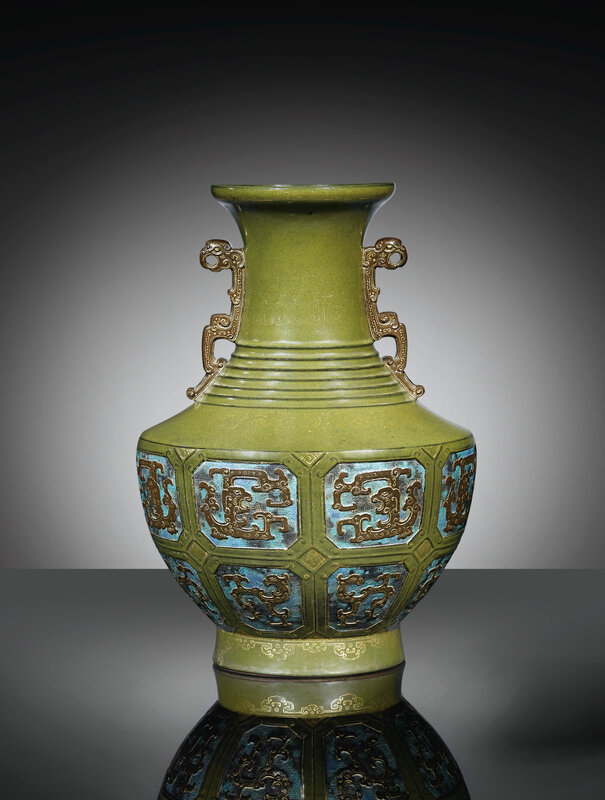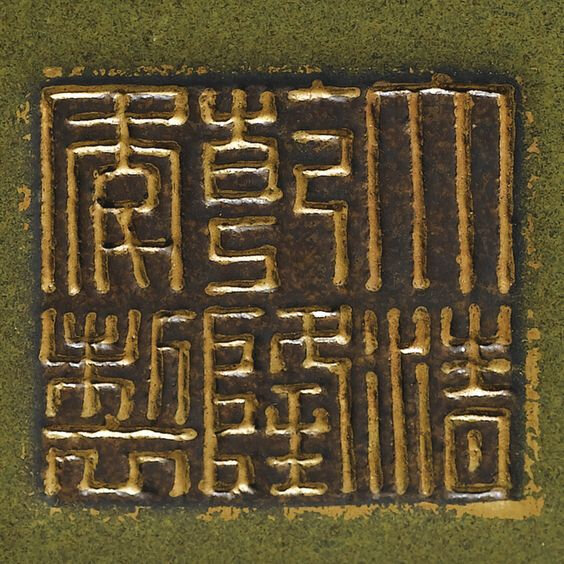Vase en porcelaine poudre de thé rehaussé d'or, hu. Chine, Dynastie Qing, marque et époque Qianlong
Lot 92. Vase en porcelaine poudre de thé rehaussé d'or, hu. Chine, Dynastie Qing, marque et époque Qianlong (1736-1795); 49 cm, 19 3/8 in. Estimate 800,000-1,200,000 EUR. Lot sold 960,750 EUR. Photo Sotheby's
la panse à décor compartimenté de panneaux agrémentés de dragons kui archaïsants moulés en relief sur fond de grecques émaillé lavande et pourpre, le col évasé décoré à l'or et flanqué d'anses ajourées en forme de phénix stylisés, la base du col rythmée de sept cercles en relief, le pied souligné d'une frise de ruyi à l'or, marque à six caractères gravée et dorée à la base
An imitating-bronze tea-dust porcelain vase, China, Qing Dynasty, Qianlong mark and period (1736-1795)
Provenance: Collection Vicomte de Noailles. Thence by family descent.

The present impressive large hu-form vase with its stylized dragon decoration belongs to a special group of porcelain vessels that took their inspiration from archaic ritual bronzes. It is one of the most impressive porcelains within a group of such vessels that simulate metal originals. The Qianlong emperor was a keen collector of ceramics, both contemporary and antiques. It is known that he greatly favoured copies or replicas, and enjoyed objects that were simulations of other materials. During his reign the refinement of materials and craftsmanship and the expansion of the range of glaze and enamel colours allowed potters to become highly ambitious in their repertoire. They were encouraged in this by the emperor who appears to have had a special liking for showy pieces. Simulations were produced that were difficult to separate from the 'real'. Zhu Yan in Tao shuo, published in 1774, noted that 'in fact, among all the works of art in carved gold, embossed silver, chiselled stone, lacquer, mother-of-pearl, bamboo and wood, gourd and shell, there is not one that is not now produced in porcelain, a perfect imitation of the original (fang xiao er xiao). (See Stephen W. Bushell, Description of Chinese Pottery and Porcelain: Being a Translation of the Tao Shuo, Oxford, 1977, p. 6).
Among the many simulations created by the imperial workshops for the Qianlong Emperor, those imitating archaic ritual bronzes appear to have been especially popular. Archaic bronze vessels, particularly of the late Shang (c.1600-c. 1050 BC) and Western Zhou (c.1050-771 BC) period, collected by Qianlong inspired precise copies as well as 'modern' interpretations, like the present vase. Soame Jenyns in Later Chinese Porcelain, London, 1951, p. 60, mentions that a stone tablet was excavated at the Imperial kiln site at Jingdezhen in 1915, titled 'Orders and Memoranda on Porcelain' in which Tang Ying, Superintendent in charge of the Imperial porcelain manufacture, discusses his efforts to 'counterfeit' bronze vessels.
Bronzes were simulated through a variety of glazes, typically a brown of 'café-au-lait' or 'teadust' colour heightened with gold, and this was often combined with a mottled turquoise or green glaze, as well as the glaze known as 'Robin's Egg' to evoke the blue-green patina of ancient metalwork. While a number of related pieces are known from the Qing Court collection, no simulated bronze vase of this form and decoration appears to be recorded.
The design mixes archaic motifs with Qing dynasty elements. Whereas the confronted dragons are derived from bronze designs, the gilded ruyi band around the foot and the stylized dragon handles on the neck are stylistically firmly rooted in the Qing tradition.
For examples of vessels belonging to this group see a large ovoid vase, from the J.T. Tai collection, sold in these rooms, 7th October 2010, lot 2128 ; and another massive vase in the Palace Museum, Beijing, echoing an archaic bronze zun with only a narrow band of this robin's egg glaze reserved on an overall teadust surface, illustrated inKangxi. Yongzheng. Qianlong. Qing Porcelain from the Palace Museum Collection, Beijing, 1989, p. 412, pl. 93,
together with a gu and a bell simulating bronzes, pp 414f, pls. 95 and 96. A hu-form vase in the Musée Guimet, Paris, (inventory no. G1567) is another fine example of vessels of this type; as well as a miniature version of the same form but with handles and decorated with a band executed in a similar colour scheme with coffee-coloured dragon motif raised on a mottled turquoise glaze, included in the Min Chiu Society exhibition An Anthology of Chinese Ceramics, Hong Kong Museum of Art, Hong Kong, 1980, cat. no. 138, and sold in our Hong Kong rooms, 14th November 1989, lot 340. A tripod censer of Qianlong reign mark and of the period, probably lacking any turquoise glaze but decorated with very similar stylized dragons, is published in Geng Baochang, Ming Qing ciqi jianding, Hong Kong, 1993, p. 282, fig. 486. See also a porcelain gu from the Shanghai Museum, apparently unmarked, exhibited together with a Shang dynasty bronze gu of the type it copies in the exhibition Treasures from Shanghai. Ancient Chinese Bronzes and Jades, The British Museum, London, 2009, cat. nos. 56 a and b. Large hu form vases of this type were also decorated in blue-and-white; for example, see one painted in bright shades of cobalt blue with a continuous flower scroll design, the neck flanked by a pair of handles, sold in our Hong Kong rooms, 16th May 1977, lot 90, now in the Hong Kong Museum of Art, included in the museum's exhibition The Wonders of the Potter's Palette, Hong Kong, 1984, cat. no. 63; and another with two stylized dragon handles and the body painted with branches of peach, lychee, finger-citron and pomegranate branches, with a Qianlong reign mark on the base, sold in our Hong Kong rooms, 25th April 2004, lot 299.
Sotheby's. Arts D'Asie. Paris, 15 Dec 2011

/https%3A%2F%2Fprofilepics.canalblog.com%2Fprofilepics%2F1%2F0%2F100183.jpg)
/https%3A%2F%2Fstorage.canalblog.com%2F03%2F02%2F119589%2F96711876_o.jpg)
/https%3A%2F%2Fstorage.canalblog.com%2F11%2F31%2F119589%2F94773502_o.jpg)
/https%3A%2F%2Fstorage.canalblog.com%2F20%2F83%2F119589%2F94772815_o.jpg)
/https%3A%2F%2Fstorage.canalblog.com%2F26%2F72%2F119589%2F75604929_o.jpg)
/https%3A%2F%2Fstorage.canalblog.com%2F59%2F60%2F119589%2F26458628_o.jpg)






/image%2F1371349%2F20240425%2Fob_e64568_440367995-1657703268333019-41468471616.jpg)
/http%3A%2F%2Fstorage.canalblog.com%2F63%2F62%2F119589%2F129821675_o.jpg)
/http%3A%2F%2Fstorage.canalblog.com%2F43%2F82%2F119589%2F129801198_o.png)
/http%3A%2F%2Fstorage.canalblog.com%2F40%2F90%2F119589%2F129784381_o.jpg)